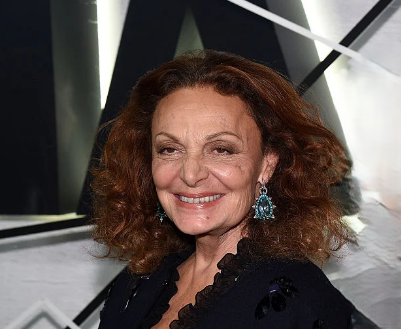Diane von Furstenberg’s 2025 net worth of $1.2 billion is more than just a monetary figure; it’s the culmination of decades spent influencing fashion, boosting self-esteem, and supporting causes that go far beyond the realm of fashion. Her ascent started in the 1970s with the invention of the wrap dress, which resonated with women who were juggling elegance and ambition. This design represented a cultural turning point, reflecting women’s growing representation in public leadership roles and corporate offices, rather than just being a commercial success.

Her life was entwined with European nobility through her first marriage to Prince Egon von Furstenberg. She retained the Furstenberg name, which by that time had become synonymous with her brand, even though their relationship ended in 1983. Her entrepreneurial instincts and significantly enhanced design sensibilities ensured she wasn’t reliant on titles for influence, even though the royal connection gave her early recognition.
Diane von Furstenberg – Personal and Professional Profile
| Category | Details |
|---|---|
| Full Name | Diane Simone Michelle Halfin von Furstenberg |
| Date of Birth | December 31, 1946 |
| Birthplace | Brussels, Belgium |
| Nationality | Belgian-American |
| Profession | Fashion Designer, Philanthropist |
| Net Worth 2025 | $1.2 billion |
| Famous For | The wrap dress, global women’s empowerment advocacy |
| Marriages | Prince Egon von Furstenberg (1969–1983), Barry Diller (2001–present) |
| Children | Alexander von Furstenberg, Tatiana von Furstenberg |
| Major Achievements | Founder of DVF, Former CFDA President, Founder of DVF Awards |
| Philanthropy | DVF Awards, Vital Voices, Diller–von Furstenberg Family Foundation |
| Notable Honors | Chevalier de la Légion d’honneur, Fashion Walk of Fame Star |
| Official Reference | www.celebritynetworth.com |
Following initial success, the 1980s presented difficulties. Her business faced major challenges as fashion cycles changed. Her comeback in the 1990s with a new wrap dress collection, however, was incredibly successful in reintroducing her to a younger audience and demonstrating that perseverance could be just as important as originality in maintaining relevance.
Two titans from different industries came together in 2001 when her friendship with Barry Diller, which had lasted for decades, blossomed into marriage. Their relationship, which is based on mutual respect and trust, has been as unusual as it is strong. Her support was particularly evident even in 2025, when Diller wrote his memoir and openly discussed his sexuality. She said that their marriage was based on love and honesty, which was reflected in their collaborative charitable endeavors.
Her impact on fashion went well beyond her personal creations. During her more than ten years as President of the Council of Fashion Designers of America, she advocated for mentorship, creativity, and inclusivity. Under her direction, up-and-coming designers discovered venues to exhibit their work, broadening the scope of a field that is sometimes criticized for being exclusive.
Her later career has been centered on philanthropy. Established in collaboration with Vital Voices in 2010, the DVF Awards have proven to be an especially useful forum for honoring female leaders who defy expectations and make a significant impact. Her participation in campaigns such as the Ban Bossy campaign boosted discussions about female ambition and inspired young women to boldly assume leadership positions.
More than $130 million has been allocated by the Diller–von Furstenberg Family Foundation to human rights, public space, education, and the arts. Utilizing their resources, the couple contributed to the transformation of urban environments, making Little Island and New York’s High Line emblems of accessibility and civic beauty. Her design philosophy is reflected in these endeavors: practical yet visionary, inspiring yet functional.
She has received many honors. She was awarded the Queen Sofia Spanish Institute gold medal in 2010, received a star on the Fashion Walk of Fame in 2009, and was named a Chevalier de la Légion d’honneur in 2020. With these accolades, she joins a small elite of creative leaders whose impact crosses the boundaries of entrepreneurship, artistry, and cultural stewardship.
Her taste and global reach are also reflected in real estate. From the Meatpacking District in New York to European getaways, she and Diller have put together properties that combine architectural distinction with personal resonance. Like her clothes, each home exhibits a harmony between comfort and style.
Her path reflects broader changes in culture. She personified a new era of female empowerment through fashion in the 1970s. Her ability to adapt was put to the test in the 1980s due to economic difficulties, but her strategic foresight was highlighted by her comeback in the 1990s. She has woven advocacy into her brand in the twenty-first century, demonstrating that purpose and profit can coexist.
In addition to her business accomplishments, Diane von Furstenberg’s current net worth demonstrates her ability to adapt to changing cultural norms without compromising her integrity. The greatest fashion icons—those who reinvent without losing their essential identity—are remarkably similar to her story. Her billion-dollar empire is evidence that resilience combined with timeless vision can leave a lasting legacy in a field where trends change quickly.
